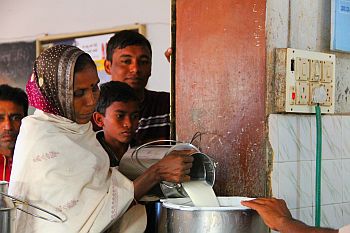Think. Eat. Save is the theme of this year’s World Environment Day. The focus is on the food choices we make and how informed decisions can reduce the environmental impact of what we eat.
IWMI researchers have been exploring the impact of water use in India’s huge dairy sector.

Photo: Abby Waldorf
India loves milk. The world’s second most-populous nation is also the world’s largest producer of milk and the demand is still rising. Indians not only drink it, they also use it to make curd, and as an important condiment for curry, make it into paneer (cheese) and even use it in religious ceremonies. As the population grows and becomes richer, the demand for milk increases. From 2000 to 2007 alone, the annual per capita consumption increased from 38 to 68kg per person and is expected to reach 102 kg/person by 2020.
The dairy sector also plays an important role in the country’s economic development. It generates about a quarter of the annual agricultural output of many rural households and particularly provides incomes for women.
However, cows are thirsty animals. The fodder to feed the animals also requires water. And processing milk products requires water too. With many regions of India becoming increasingly water stressed, the role that water plays in milk production has come under increasing scrutiny. One approach to create better understanding of this relationship is to look at the consumptive water use or water footprint of the dairy production process. This measurement assimilates ‘blue’ (consumed surface water and groundwater), ‘green’ (consumed rainwater) and grey water (water required to dilute pollutants in the production process).
A recent study carried out by the International Water Management Institute (IWMI) analyzed the water footprint of milk production in India and its implications for production. Based on the results the research team suggested how milk production could contribute to sustainable water use. The study included 448 districts in India accounting almost 92% of the total land and 95% of the total population.
“Our analysis showed the strong nexus between water use and milk and crop production, as water directly contributes to the production of milk through feed crops and through drinking water”, says IWMI researcher Upali Amarasinghe. “But, indirectly milk production depletes even more water in virtual form, as large amount of water is also embedded in by-products that feed animals. In fact, the real water footprint of milk appears as large as that of sugarcane, and the real and virtual water footprint combined is as large as that of rice.”
Irrigation, mainly from groundwater, is contributing to almost half of the total water footprint of crop and milk production. Further analysis of the water productivity of milk and crop production, they could show that the water productivity of milk is higher than high-water consuming crops such as sugarcane and rice. Many of the large milk-producing districts are dependent on groundwater for agricultural production and many deplete more groundwater than it is being replenished. This means that agricultural production at the present level, let alone under future growth, is not sustainable under current water-use patterns. Urgent action is required to keep up with the growth of milk and crop production.
To counteract unsustainable groundwater use, the researchers propose large-scale policy interventions that promote agricultural diversification. “From exclusively groundwater intensive crops to a more diverse system including higher-value low water consuming crops and milk production can bring many benefits. These includes reduced groundwater depletion, increased agricultural outputs and reduce agricultural energy consumption”, says Amarasinghe.

